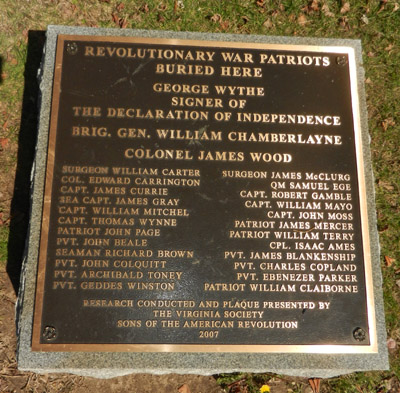Biography of Colonel James Wood II, Governor of Virginia
Note: There is no known portrait or drawing of Col. James Wood, II

Colonel James Wood Jr. was born in
Frederick County, Virginia on January 28, 1741.
His father James Wood Sr. was the founder of Winchester, Virginia
and held important county military and judicial positions and fought
with George Washington in the Ohio River area in 1754.
James Wood Jr. followed in the footsteps of his distinguished father and in February 1760 was appointed Deputy Clerk of the County Court and elected Clerk of the Vestry of Frederick Parish and from 1766 to 1775 he was the county representative to the Virginia House of Burgesses. During this time he married Jane Moncure, but the marriage bore no children. He was commissioned a Captain of Virginia Troops by Lord Dunmore in 1774 and fought in the successful Battle of Point Pleasant in the Ohio Valley which led to peace with the Indians.
In 1776 James Wood Jr. was appointed Lieutenant Colonel of Frederick County Militia and in February 1777 he was appointed Commander (Colonel) of the 12th Virginia Continental Line which moved north to join George Washington in the spring. He and his men endured some of the heaviest fighting at the Battles of Brandywine, Germantown, Monmouth and Fort Poulus. He was personally commended by General George Washington for his bravery, a rare accolade from the American Commander-In-Chief. Following further combat along the New Jersey shore, Colonel Wood, thinking the British Carlisle Commission might bring an end to the war, applied to resign his commission, which was rejected by General Washington who viewed Wood too valuable and gallant an officer to lose. The Continental Army was reorganized in late 1778 and he was placed in command of the 8th Virginia Regiment, which held remnants of the 12th Virginia Regiment.
During November and December 1779 the 3,500+ British and German prisoners of war captured at the Battle of Saratoga in October 1777, were moved from Cambridge, Massachusetts down through Connecticut and Pennsylvania to Albemarle, Virginia on the outskirts of Charlottesville. Known as the Convention Army these prisoners presented a huge security and logistical challenge for Colonel Wood who was named Commissary (Quartermaster) and then Commander of these POWs. Despite severe resource shortages Colonel Wood managed to treat these enemy soldiers with compassion and dignity.
In the February 1781 Colonel Wood was ordered to move the POWs from Albemarle on short notice to Winchester, Virginia by the Governor of Virginia, Thomas Jefferson, because of the possibility that Brigadier General Benedict Arnold attacking up the James River and General Cornwallis moving into southern Virginia might liberate the Convention Army POWs. The POWs spent four months in Winchester before being divided into smaller groups and spread throughout the towns of the area.He continued in that capacity until it was dissolved in January 1783, when he was promoted a brigadier of state troops.
After the War Wood supported the Federal Constitution and as a member of Virginia's Electoral College cast his vote for General Washington as our Nation's first president. Having served as a member of the Executive Council of Virginia since 1784 he was elected Governor of Virginia and served from 1796 to 1799 and served as the President of the Society of Cincinnati from 1802 until his death in 1813.He was buried with full military honors in Richmond in St. John's churchyard.
Colonel James Wood II distinguished himself by valor in battle, honor and integrity in managing the largest group of enemy prisoners held by the Americans, and excellence and dedication in serving the citizens of Virginia.We the members of the Winchester Chapter of the Sons of the American Revolution are humbled and honored to have him as our chapter namesake.
This Biography was edited by Compatriot Paul Chase, a member in good standing of the Colonel James Wood II Chapter.



